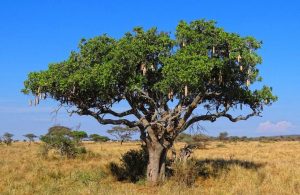Carissa spinarum, Apocynaceae family, is a shrub which is indigenous to tropical Africa. Previously scientists had named this plant Carissa edulis. The plant has been a source of inspiration for a number of communities. It is very popular among many communities in Africa due to its enormous food and medicinal benefits.
This shrub-like plant is a spiny, branched, thorny, small plant growing up to 5 meters high. Its leaves are ovate to ovate-elliptic, opposite, occasionally almost circular, 2.5 x 1.8-3 cm, leathery, dark green above, paler green below, with short, soft hairs, dark lateral veins, apex tapering and often with a bristle-like tip. The flowers are white tinged with purple, red or pink, and are up to 1.8 cm long, about 2 cm in diameter, slender, tubular. The flowers have corolla lobes overlapping to the right and are sweetly scented. The fruits are berry-like with a whitish milky sap, almost spherical in shape, with average diameter of 1.1 cm, a purplish black colour on ripening and a 2-10 cm small flat seed.
Carissa spiranum is known in different dialects in Africa. For example, in Uganda, the plant is known as ‘Acuga’ by the Luo ethnic group, ‘Amuria’ by the Ateso ethnic group and ‘Muyonza or enyonza’ by the Ganda, Runyankore-Rukiga ethnic groups. It is commonly known among the Hausa tribe in Northern Nigeria as ‘cizaki’, and in Malawi as ‘Mpambala Myoloko’, while the Kamba of Kenya refer to it as ‘mukawa’ and it is called ‘mtandamboo’ in the Kiswahili language.
Historically, the Carissa spinarum plant has provided a source of inspiration for a number of communities. The plant is very popular among many different communities in Africa, due to its enormous food and medicinal benefits. The fruits are sweet and are a delicacy to many people as they are eaten as snacks. The fruit pulp can also be used in the production of red wine and juice.
In African ethnomedicine, Carissa spinarum is one of the most prevalent traditional cures for a myriad of diseases. All the plant parts, roots, barks, leaves and even the fruits are used to treat many diseases. As a multipurpose medicinal tree, some communities across Africa refer to Carissa spinarum as the ‘magic herb’ because it is used to cure several diseases including: headache, chest complaints, rheumatism, gonorrhea, syphilis, rabies, herpes, malaria, sickle-cell anaemia, hernia, oedema, toothache, cough, ulcer, worm infestation and as a diuretic, among others.
Recently, Carissa spinarum gained a lot of prominence in East Africa; in 2011 thousands of people in and outside Eastern and Central Africa flocked to the remote Samunge village in Tanzania with their sickly, loved ones for treatment by the catholic priest against many diseases including infertility, hypertension, diabetes, asthma, cancer and Acquired Immunodeficiency Syndrome (AIDS) through elimination of the causative agent, the Human Immunodeficiency Virus (HIV).
The medicinal plant used by the priest to treat people was Carissa spinarum. Across Africa traditional healers use the decoctions of its roots as a pain killer for abdominal pains and an infusion of its powdered root is a remedy for malaria, chest complaints, stomachache, a cough remedy, eye cataracts, polio, cancer, hypertension, kidney complication and for treating infertility, diabetes, asthma, rheumatism, sickle-cell anaemia, hernia, typhoid fever, jaundice, and measles. The decoction from the pounded root is also administered to treat epilepsy in some communities. In some cases, the patient is made to inhale the vapours coming from the root infusion to treat the epilepsy.
The traditional birth attendants (TBAs) use the decoction from dried leaves to increase labour and bring about quick child delivery especially during difficult labour.
Because of it enormous ethnomedicinal uses, scientists have been investigating the medicinal bioactive compounds in the different plant parts of Carissa spinarum. The roots and leaves extracts have been found to possess, benzenoids, penylpropanoid, lignans, sesquiterpenes, cumarins, steroids, terpenes, tannins, flavonoids and cardiac glycosides. These bioactive compounds have several biological functions and this explains the extensive use of this plant in the treatment and management of many types of diseases by traditional medical practitioners.
Like the roots, a decoction from the leaves and bark of Carissa spinarum is used in many societies in Africa in the treatment and management of breast cancer, headache, chest pains, lowering blood pressure, rheumatism, syphilis, rabies, immune booster, fever, oedema, cough, ulcer, malaria, and to relieve toothache. The ripe fruits are eaten as snacks to treat and manage dysentery.
Apart from the plant being used as one of the most valued traditional medicinal plants and fruit trees, it has also found many other applications in a number of communities. For instance, Carissa spinarum can be an ornamental plant due to its abundant branching habit and the presence of thorns that make it suitable as a protective hedge plant, while its fruits are gathered and eaten as food and for the processing of traditional natural dyes.
In conclusion, the Carissa spinarum tree remains one of the most interesting and highly valued medicinal plants in a wide range of communities in Africa; one that can be relied on to treat and manage various disease conditions. Fortunately, this plant is one of the most resistant ones, capable of surviving in a number of extreme climatic conditions and thus making it easy to be accessed by the populace.
– Komakech Richard and Omujal Francis






